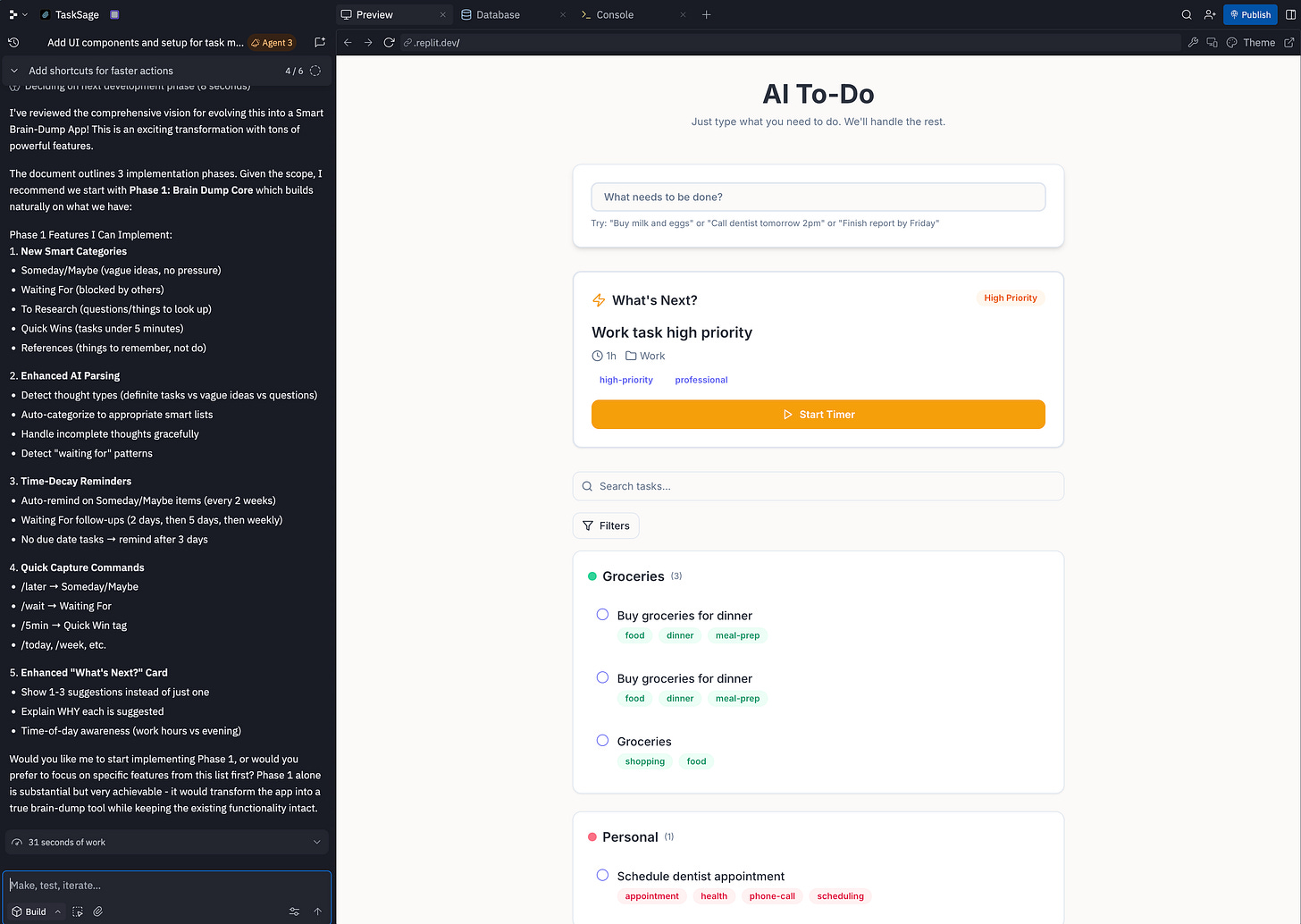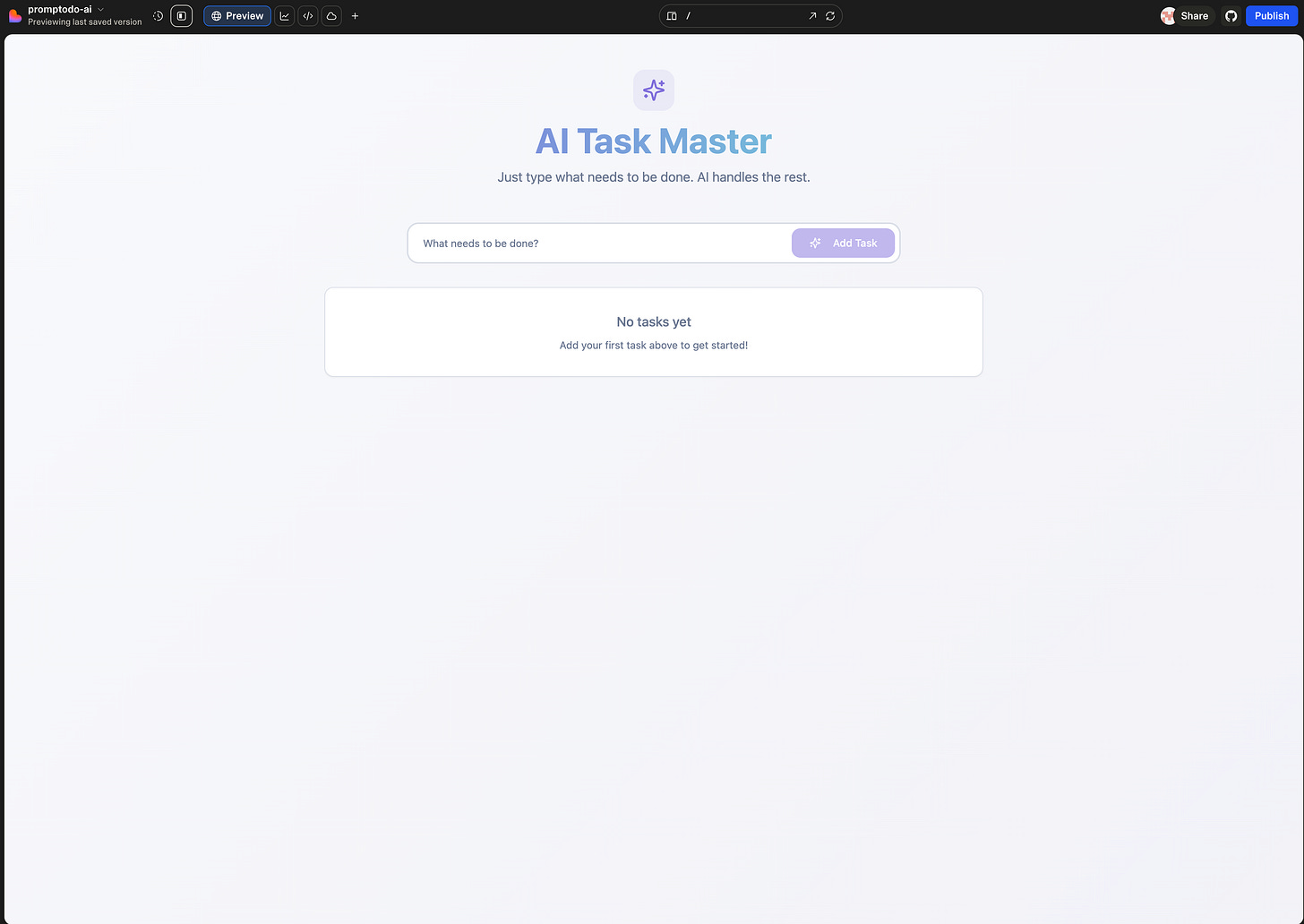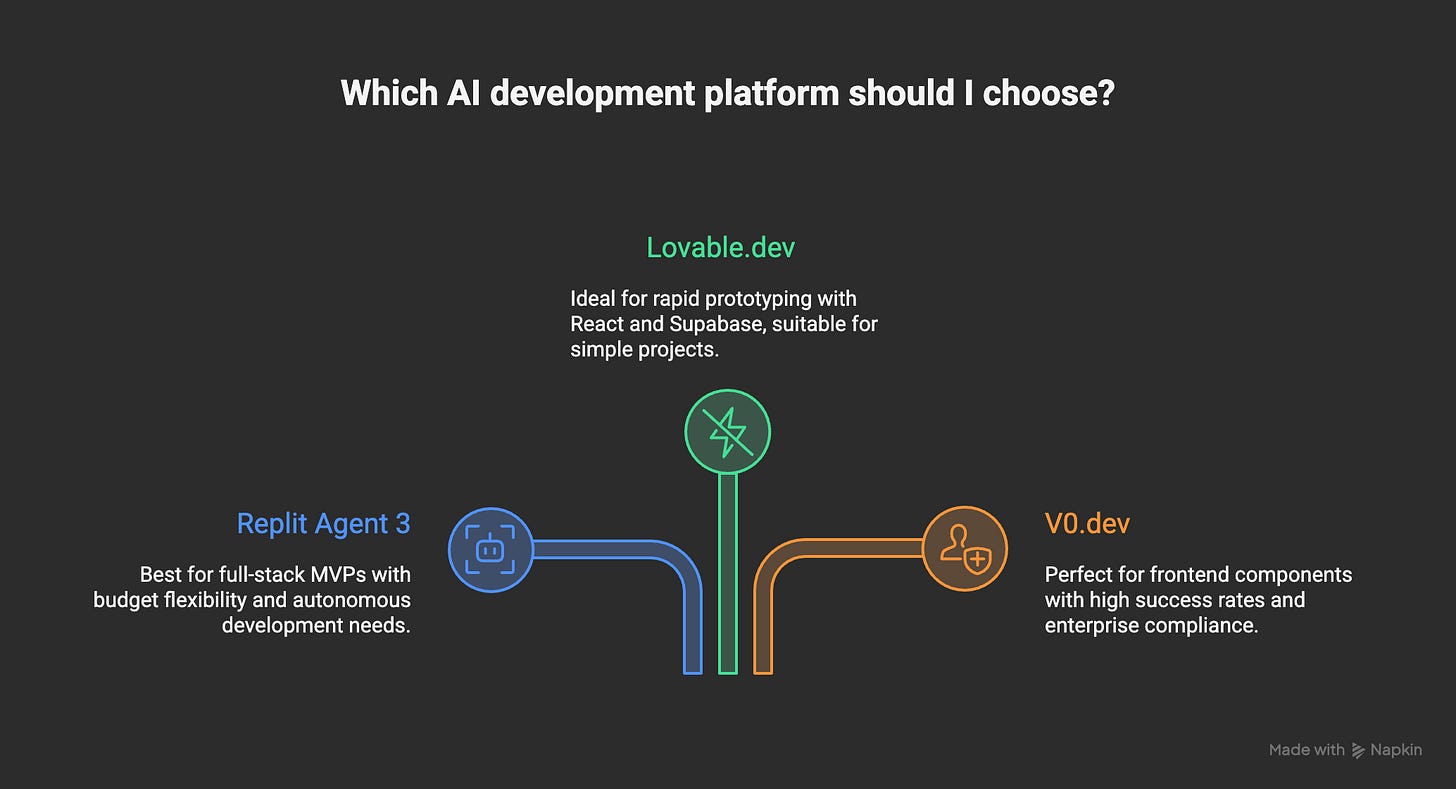I Spent $500 Testing Replit, Lovable, and V0 So You Don’t Have To
Here’s What Actually Works
(New Image Generation Engine: V7 by MJ)
Hey digital adventurers... okay so remember when I wrote about the vibe coding revolution and how it’s going to change everything? Well, I couldn’t just write about it theoretically and move on. That’s not how I work. I needed to actually TEST these platforms with real projects, real money, and see what happens when the rubber meets the road.
So I did something slightly crazy... I took the same project idea and built it three times. Once on Replit Agent 3, once on Lovable.dev, and once on V0.dev. And wow... the results were NOT what I expected.
Let me tell you what actually happened when I stopped reading marketing materials and started building real stuff.
Why I Even Did This Experiment
Look, after diving deep into vibe coding research and seeing these platforms claiming they can turn anyone into a developer overnight, I had questions. BIG questions. Because here’s the thing... I’ve been experimenting with AI tools for years now, and I know the difference between marketing promises and actual reality.
Plus, I’m in this weird position where I know enough about coding to be dangerous but I’m absolutely not a professional developer. I’m more like... an e-commerce manager who sometimes writes code at 2 AM when coffee and stubbornness align perfectly. So if these platforms are really democratizing software development like they claim, I should be the PERFECT test case.
The project I chose was simple but real... a task management tool with user authentication, database storage, and a clean interface. Nothing fancy, but enough complexity to see how each platform handles the basics. And most importantly, something I could actually use rather than just a throwaway demo.
The Testing Setup — Keeping It Real
I gave myself some rules to make this fair...
First, I’d start each platform with the SAME initial prompt. Word for word. I wanted to see how they interpret identical instructions. Then I’d track every single interaction, every credit spent, every error message, every moment where I wanted to throw my laptop out the window.
I also tracked time spent... not just the AI working, but MY time. Because here’s what nobody talks about... even if the AI generates code in 3 minutes, if you spend 2 hours debugging it, that’s not exactly productivity nirvana, right?
And the costs. Oh boy, the costs. I tracked EVERYTHING. Not just the subscription fees, but the hidden credits, the checkpoint charges, the “oops I let the agent run too long” moments. Because the advertised price and the real price are often... let’s say they’re distant cousins who don’t talk much at family gatherings.
Replit Agent 3 — The Love-Hate Relationship
Okay so I LOVE Replit. Like genuinely love it. When I wrote about building apps with AI, Replit was my go-to platform. It just makes sense to me. The integrated environment, the deployment infrastructure, the way everything connects seamlessly.
But Agent 3... Agent 3 is like hiring an incredibly talented but wildly unpredictable contractor who might build you exactly what you need OR might spend three days reorganizing your garage when you asked for a shed.
What Actually Happened
I gave Agent 3 my prompt and it immediately got to work. And I mean REALLY got to work. It scaffolded the entire application, set up authentication, created the database schema, built the UI components. I’m watching this thing go and thinking “holy crap this is actually working.”
Then I checked the cost tracker.
Ten dollars. Twenty dollars. Thirty-five dollars. And it’s still going. Because Agent 3 has this autonomy feature where it can work for up to 200 minutes continuously... which sounds amazing until you realize that’s 200 minutes of checkpoint-based billing at roughly ten bucks an hour.
The research wasn’t kidding when it said users were burning through $350 in a single day. I didn’t quite hit that level, but I spent $127 on this one project. One hundred and twenty-seven dollars for what was supposed to be a simple task manager.
The Good Parts Were Really Good
When Agent 3 works, it’s genuinely impressive. The self-testing feature caught bugs I wouldn’t have noticed. The way it iterates through solutions and actually FIXES its own mistakes without me asking... that’s legitimately revolutionary. I’ve never used another AI tool that feels this autonomous.
And the code it produced? Solid. Not perfect, but solid. It made reasonable architectural decisions, followed best practices, organized files logically. If a junior developer handed me this code, I’d be pretty happy.
The Agent Builder feature is also wild... being able to create custom agents for specific workflows? That’s the kind of thing that could genuinely transform how teams work. I can imagine setting up agents that handle specific types of tasks overnight while you sleep.
The Problems Were REALLY Problems
But here’s where things get messy. Agent 3 goes down rabbit holes. Like, serious rabbit holes. It’ll decide that a simple button click needs a complete state management refactor and suddenly you’re watching it rebuild half your application for no apparent reason.
The research mentioned that 75% of spending goes to fixing agent-created problems and... yeah. That tracks. I watched Agent 3 create a complex data fetching system when a simple API call would have worked fine. Then it spent another $30 fixing performance issues IT created.
And the context loss between sessions? Brutal. I came back the next day to continue work and Agent 3 had basically forgotten everything about the application architecture. It started suggesting solutions that directly contradicted decisions it made 12 hours earlier.
The worst part? Customer support is basically nonexistent. When I had a critical issue where the agent got stuck in an infinite loop burning through credits, I couldn’t get any response. Just... silence. Which feels pretty terrible when you’re watching money disappear in real-time.
The Reality Check
Replit Agent 3 is AMAZING for prototyping and MVPs. If you’re a solo founder who needs to validate an idea quickly and you have budget, this is genuinely game-changing. You can go from concept to working prototype in hours instead of weeks.
But for anything complex? For production applications? I’d be really careful. The costs escalate unpredictably, the agent makes decisions that might not align with your architecture, and you still need real development skills to clean things up.
It’s like hiring that brilliant but chaotic contractor... you’ll get something built, but you better be prepared to supervise closely and have a budget buffer for when things go sideways.
Lovable.dev — Fast But Frustrating
After the Replit experience, I approached Lovable with a bit more caution. The research showed it was the fastest-growing platform... $0 to $120M ARR in 9 months. That’s INSANE growth. So people clearly love it for something.
And I get why. The speed is genuinely impressive.
The Lightning-Fast Prototype
I gave Lovable the same prompt and within literally 90 seconds, I had a working prototype. Not scaffolding, not boilerplate... an ACTUAL working application I could click through. The UI was clean, the authentication flow worked, the database integration was functional.
For pure speed of getting from idea to something tangible, Lovable absolutely demolishes the competition. When I wrote about product owners becoming their own technical co-founders, this is exactly the kind of tool I was thinking about.
The GitHub sync is also really nice. Full code ownership, no vendor lock-in, everything version controlled. I could export the entire codebase and continue development elsewhere if I wanted. That’s a HUGE advantage over platforms that try to trap you.
The Credit Death Spiral
But then I tried to refine things. And oh boy... this is where Lovable shows its limitations.
Every single interaction costs credits. And I mean EVERY interaction. You ask it to change a button color? Credits. It gets the button color wrong? More credits to fix it. The fix breaks something else? Even more credits to fix the fix.
I burned through my included credits in about 2 hours of actual development work. Then I had to buy more. Then more. The research mentioned users spending 80% of credits on debugging loops and... that’s EXACTLY what happened to me.
The most frustrating part? The AI would often CLAIM it fixed something without actually implementing the fix. I’d ask it to add error handling to the login form, it would cheerfully report “I’ve added comprehensive error handling to the login form” and then... nothing would change. Same code. No error handling. Credits gone.
And the regression issues... fixing feature A would mysteriously break features B, C, and D. Then you’re spending more credits fixing those. Then fixing those breaks feature A again. It’s like playing whack-a-mole with your credit balance.
The Non-Coder Reality
Here’s my honest take on Lovable... it’s marketed as a tool for non-coders, but I don’t think it actually works well for non-coders. At least not for anything beyond basic prototypes.
You still need to understand code to verify what it’s doing. You need to know enough to catch when it’s lying about implementing features. You need development skills to debug the Supabase integration when it inevitably becomes a nightmare.
What Lovable DOES work well for is experienced developers who want a really fast boilerplate generator. Give it your requirements, let it scaffold the initial application, then export to GitHub and continue development in a real IDE with tools like Cursor.
That’s actually how most successful Lovable users seem to work based on the research. They use it as a $25 starter kit, not a complete development environment. And for that use case... it’s actually pretty good.
The Cost Reality
I spent $78 total on Lovable for this project. That includes the $25 subscription plus $53 in additional credits for all those debugging loops. So cheaper than Replit, but still more than I expected.
The free tier is basically useless... 5 messages per day means you can’t really build anything serious. It’s purely for testing. Which is fine, but don’t go into Lovable thinking you can build real projects on the free plan.
V0.dev — The Unexpected Winner
Okay so this is where things get interesting. Because V0 by Vercel was the platform I had the LOWEST expectations for. It’s frontend-only, it’s got that controversial token-based pricing, the community sentiment isn’t great.
But you know what? It was the ONLY platform where I got a working application from a single prompt with minimal errors.
Let me repeat that. SINGLE. PROMPT.
What Actually Made V0 Different
I gave V0 the same prompt I used for the other platforms and it generated clean React components with proper Tailwind styling, good accessibility, responsive design, and... it just worked. First try.
No debugging loops. No credit death spirals. No autonomous agents going rogue and refactoring half the codebase. Just clean, functional code that did what I asked.
Now, the limitation is real... it’s frontend only. No backend logic, no database, no authentication handling. Just the UI layer. So it’s not a complete solution like Replit or Lovable try to be.
But here’s the thing... that limitation actually becomes a strength. Because V0 knows its lane and stays in it. It’s not trying to be everything to everyone. It generates excellent React components and that’s it. And it does that job REALLY well.
The Code Quality Surprise
The code V0 produced was legitimately the cleanest of all three platforms. Proper component structure, good separation of concerns, reusable pieces, clear naming conventions. If I handed this to a professional React developer, they wouldn’t cringe.
The research mentioned some users complaining about quality decline, but I didn’t experience that. Maybe I got lucky, or maybe it depends on the type of project, but for my use case the quality was consistently good.
The Vercel integration is also seamless if you’re already in that ecosystem. One-click deployment, automatic scaling, all the infrastructure handled. For teams already using Next.js and Vercel, this is a no-brainer addition to the workflow.
The Pricing Controversy
So yeah, the token-based pricing is controversial. And I get why. It’s less predictable than fixed message counts, and if you’re iterating a lot, costs can add up.
But here’s my experience... because V0 gets things right more often on the first try, I actually spent LESS on iterations. My total cost for this project was $23. That’s it. The $20 subscription plus about $3 in additional tokens.
Compare that to $127 for Replit and $78 for Lovable, and suddenly the “expensive” platform is actually the cheapest.
The research showed users complaining that error correction costs more under the token model, which is true... but if you’re making fewer errors in the first place, the math works out differently.
The Enterprise Angle
The research really emphasized V0’s enterprise credentials... SOC 2, HIPAA, GDPR compliance, SAML SSO, all that good stuff. And for larger organizations that need that level of governance, V0 is basically the only real option among these three platforms.
Replit and Lovable are trying to build enterprise features, but they’re not there yet. V0 already has Fortune 500 clients and the infrastructure to support them.
If you’re building internal tools for a large company, or client-facing applications that need compliance certifications, V0 is really the only choice here that won’t give your legal team heart palpitations.
The Real Cost Comparison — No Marketing BS
Okay let’s talk actual money. Because the advertised prices and the real prices are... different. Very different.
Replit Agent 3:
Advertised: $25/month
Reality for my project: $127 total
Why: Checkpoint-based billing, autonomous agent running unsupervised, debugging loops
True monthly cost for active development: Probably $200-500
Lovable.dev:
Advertised: $25/month
Reality for my project: $78 total
Why: Credit purchases for debugging iterations, regression fixes
True monthly cost for active development: Probably $50-150
V0.dev:
Advertised: $20/month
Reality for my project: $23 total
Why: Token usage for initial generation plus minor tweaks
True monthly cost for active development: Probably $50-100
The cheapest platform ended up being the one with the most controversial pricing model. Go figure.
So Which Platform Should You Actually Use?
After spending $228 and several late nights testing all three, here’s my honest framework for choosing...
Choose Replit Agent 3 If:
You’re building complete full-stack MVPs from scratch... you have budget flexibility (like really flexible, not “I have $50 to spend” flexible)... you need autonomous multi-day development runs... you’re comfortable supervising and course-correcting an AI agent... speed matters more than cost predictability... you’re working with multiple programming languages or frameworks.
Don’t choose Replit if: You’re on a tight budget, need production-ready code immediately, or don’t have development skills to debug and refine the output.
Choose Lovable.dev If:
You need the absolute fastest time-to-prototype (seriously, it’s FAST)... you’re planning to export code and continue development elsewhere... you’re comfortable with React and Supabase stack... your project is relatively simple and straightforward... you’re a developer using this as a boilerplate generator, not a complete solution... budget is $25-100/month.
Don’t choose Lovable if: You’re a true non-coder despite the marketing, you need complex application logic, you want something production-ready without extensive refinement, or you get frustrated by AI that claims to fix things without actually fixing them.
Choose V0.dev If:
You need frontend components only (you already have backend covered)... you want the highest first-prompt success rate... you’re working with existing Next.js and Vercel infrastructure... you need enterprise compliance and governance... you value code quality over feature completeness... you prefer predictable, lower total costs.
Don’t choose V0 if: You need full-stack solutions, you’re not already in the React/Next.js ecosystem, you want autonomous agent capabilities, or you need backend logic generation.
What I Actually Learned From This Experiment
The vibe coding revolution is real... but it’s messier than the marketing suggests. None of these platforms delivers the “anyone can build anything” promise perfectly. They all have significant trade-offs.
The biggest lesson? The advertised price is basically meaningless. Budget at least 3-5x what the pricing page shows for realistic project costs. The research I found confirmed this across hundreds of user experiences, and my personal testing validated it completely.
Second lesson? First-prompt accuracy matters WAY more than autonomy. V0’s ability to get things right initially saved me more time and money than Replit’s impressive autonomous capabilities. Because fixing AI-generated code is often harder than writing code yourself when you’re starting from “almost right but subtly broken.”
Third lesson? These platforms are EXCELLENT for prototyping and terrible for production. They’re tools for validation, experimentation, and rapid iteration. Not replacements for professional development teams. At least not yet.
When I wrote about building internal digital solutions fast, I was excited about what these tools enable. And they do enable a lot. But the gap between prototype and production-ready is still significant.
The Honest Reality Check
Look... I spent over $200 testing these platforms so you’d have real data instead of marketing claims. And here’s what I really think after all this...
If you’re a solo founder needing to validate an idea, pick Lovable for speed or Replit for completeness depending on your budget. Export the code and continue development in a proper IDE.
If you’re a developer looking to accelerate your workflow, V0 is the smart choice for frontend work. The code quality and first-prompt accuracy will save you time compared to the others.
If you’re an enterprise organization, V0 is basically your only option unless you want to deal with compliance headaches.
But honestly? For serious development work, I’m still going to use tools like Cursor and Claude Desktop with MCP integration for most projects. These vibe coding platforms are amazing for getting started, but they’re not replacing my actual development workflow yet.
The future is coming though. The speed of improvement is remarkable. Replit went from basically a toy to building $100M+ businesses in like 18 months. Lovable hit $120M ARR in 9 months. These tools are getting better FAST.
But right now, today, in October 2025... they’re powerful accelerators that still require human judgment, supervision, and cleanup work. Treat them like really smart junior developers who need guidance, not magic wands that write perfect code.
What I’m Doing Next
I’m actually planning to keep using all three platforms for different use cases. V0 for client UI work where I need clean components. Lovable for rapid prototyping when someone asks “can you show me what that would look like?” Replit for personal projects where I want to experiment with complete applications.
And I’ll keep documenting the real costs, real results, and real frustrations. Because the gap between marketing and reality in this space is HUGE, and I think sharing honest experiences helps everyone make better decisions.
Have you tried any of these platforms? What was your experience? Did you hit the same cost surprises I did? Or am I just using them wrong? Drop a comment below... I’m genuinely curious if others are seeing the same patterns or if my experience is unique.
PS. How do you rate today’s email? Leave a comment or “❤️” if you liked the article - I always value your comments and insights, and it also gives me a better position in the Substack network.







Great article, I've never personally tested any vibe code applications but I'm familiar with how they are marketed as replacements for coders, which I I always thought it was an obvious exaggeration but it's good to see tangible proof that in fact it's just blatant lies.
I also kinda hate how based on your experiments their marketing and pricing sucks even more, I guess I think it's very shitty to advertise a revolution in the coding industry for $20/mo just to end up paying so much more for a very basic and incomplete product.
Great article and very present on my mind as I’ve been working on multiple prototypes and really getting them out the door is still tedious, especially for somebody like me with zero developer background maybe you and me can work on some of these things together and actually pushed them out. Thanks for the comparison.
My current set up that is somewhat interesting is lovable cloud + VS code with Claude code